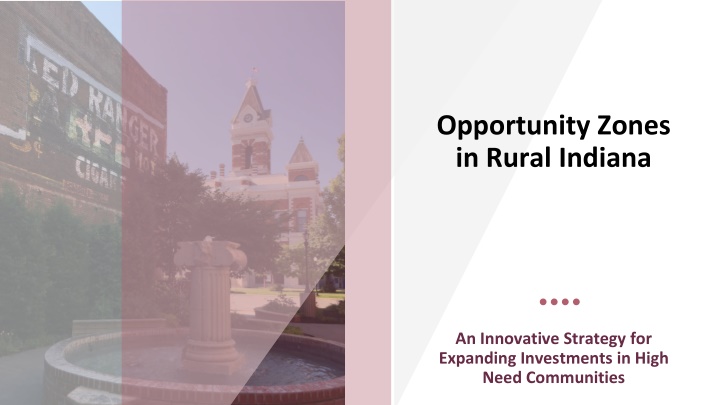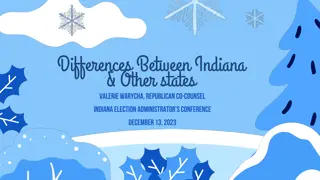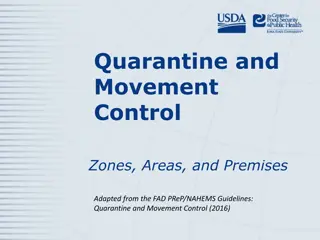Opportunity Zones in Rural Indiana: Driving Investments in High-Need Communities
The presentation discusses the Opportunity Zones program in rural Indiana aimed at boosting investments in underserved communities. It covers the purpose of Opportunity Zones, how they originated, their selection process in Indiana, the program's mechanics, potential investment areas, the New Rural IN Opportunities Zones Initiative, complementary funding programs, benefits for selected sites, and a Q&A session. The program, established through federal legislation, seeks to drive capital infusion into low-income urban and rural areas to stimulate economic growth and development beyond major metropolitan hubs.
Download Presentation

Please find below an Image/Link to download the presentation.
The content on the website is provided AS IS for your information and personal use only. It may not be sold, licensed, or shared on other websites without obtaining consent from the author.If you encounter any issues during the download, it is possible that the publisher has removed the file from their server.
You are allowed to download the files provided on this website for personal or commercial use, subject to the condition that they are used lawfully. All files are the property of their respective owners.
The content on the website is provided AS IS for your information and personal use only. It may not be sold, licensed, or shared on other websites without obtaining consent from the author.
E N D
Presentation Transcript
Opportunity Zones in Rural Indiana An Innovative Strategy for Expanding Investments in High Need Communities
Todays Presenters Bo Beaulieu, Director Purdue Center for Regional Development ljb@purdue.edu Matt Crouch, Deputy Director Office of Community and Rural Affairs MCrouch@ocra.IN.gov
Special Thanks For awarding our team a 2019 Rural Business Enterprise Grant to advance our Opportunity Zone Work in Rural Indiana.
Webinar Sponsors Office of the Lieutenant Governor Suzanne Crouch 5
Todays Topics What are Opportunity Zones (OZs)? How did OZs come about and why? The OZ selection process and Rural OZs in Indiana OZ Program: How it works Investing in OZs: Some possible areas The New Rural IN Opportunities Zones Initiative Application timeline and selection process A Look at complementary funding programs Benefits to your OZ site, if selected Questions and Answers
What is the Opportunity Zones Program? An effort designed to invest capital in underserved areas of the country, places in need of an influx of money to jump- start their economies. Source: Jeff Andrews, October 2018 www.curbed.com/2018/10/3/17898370/opportunity-zones-tax- bill-community-development-capital-gains
Opportunity Zones: A Product of Federal Legislation The OZ program was established by the U.S. Congress as part of the 2017 Tax Cuts and Jobs Act. It represents an innovative approach to promote long-term investment by the private sector in low-income urban and rural communities across the U.S. Opportunity Zones are chosen by the Governors of each state and subsequently approved by the U.S. Treasury Department.
Why the Need for an Opportunity Zones Program? Economic growth is happening in a handful of metropolitan areas of the U.S. But, economic expansion must occur in more communities, including rural areas. Three of every four distressed counties in the U.S. have fewer business establishments today than they did in 2007, just prior to the Great Recession. These areas have witnessed a decline in business formations. Furthermore, they have fewer employers, innovators & service providers. Sources: Fikri and Lettieri, December 2018; LISC, not dated
Selection of Opportunity Zones: The Process Up to 5% of the nominated Opportunity Zone tracts could be non-low income sites as long as they were contiguous to a qualified, nominated tract and their median family income did not exceed 125% of the adjacent qualified tract. Governor could nominate 25% of these eligible tracts as Opportunity Zones State identified all Census Tracts with income at or lower than 80% of the median family income of the state and a poverty rate greater than 20%* Nominated tracts were then submitted and approved by the U.S. Treasury Dept. Designation is for 10 years. * Different requirements for rural vs. metro tracts 10
Indiana Opportunity Zones 156 Lorem ipsum dolor sit amet, consectetuer adipiscing elit. Maecenas porttitor congue Number of Zones Meeting the Rural Definition* 46 * Rural Definition: Any area other than a city or town that has a population of greater than 50,000 and an urbanized area contiguous and adjacent to such a city or town (according to the latest decennial census). Map of Rural Opportunity Zones
Demographic and Economic Features of Opportunity Zones in Indiana, 2017 All Indiana Opportunity Zones (n = 156) Rural Opportunity Zones (n= 46) 563,523 Average: 3,439 182,553 (34%) Average: 3,969 Population Total Jobs & Unemployment 233,074 9.8% 79,520 (34.1%) 7% Average Poverty Rate/Range 29.1% (8.3% - 75.1%) 20.5% (8.3% - 35.2%) High School: 41.2% Some College/Associates: 27.9% College +: 13.2% High School: 35.2% Some College/Associates: 28% College +: 17.9% Education (average) Manufacturing: 17.9% Entertainment: 12% Services: 8.7% Manufacturing: 25% Entertainment: 9.6% Services: 5.9% Key Industries (average) 13
Opportunity Zones: How They Work Investors has 180 days from the point of sale of an asset to invest (into a QOF) Qualified Opportunity Fund (QOF) Invest in Eligible Projects Intent is to connect potential investors with capital gains to re-invest in economically distressed communities that could benefit from such investments.
What is a Qualified Opportunity Fund (QOF) A mechanism that is designed to invest in eligible property located in an Opportunity Zone. The fund uses the investor s gains from a prior investment for funding the Opportunity Fund. A QOF has six months to deploy 90% of its capital in Ozs. 15
How are Qualified Opportunity Funds Created? To become a Qualified Opportunity Fund, an eligible corporation or partnership self-certifies by filing Form 8996: Qualified Opportunity Fund with its federal income tax return. No approval or action by the Internal Revenue Service is required. Any taxpayer who wishes to participate in the Opportunity Zone program can do so (but it must be in a Qualified Opportunity Fund). 16
Benefits to the Investor: Increases Over Time Benefits Received Investment Length Deferred payment on existing capital gains until the date that the Opportunity Fund investment is sold or exchanged. Less than 5 years 5-7 years Benefits above plus 10% of tax on existing capital gain is canceled Deferred payment of exiting capital gains until December 2026 or the date that the Opportunity Fund investment is sold or exchanged (whichever comes first) PLUS 15% of tax on existing capital gain is canceled. 7-10 years Benefits of the 7-10 years investment PLUS investor pays no capital gains tax on the Opportunity Fund investments (that is, investments are exempt from any capital gains beyond those which were previously deferred) Greater than 10 years Source: LISC. See: https://ofn.org/sites/default/files/resources/PDFs/Opportunity_Zone_fact_sheet.pdf 17
Example of the Benefit of a Long-Term Investment in a QOF In 2018, an individual investor sells 1,000 shares of Amazon stock that was purchased in 2013 for $250,000. The sale at $1,250 per share results in a $1 million capital gain. Instead of paying the $238,000 in federal capital gains tax on this sale, the investor rolls the $1 million gain into a Qualified Opportunity Fund that invests the capital in newly issued shares in various operating businesses located in Opportunity Zones. Let s assume that the value of that investment is $2 million in 2028. The benefit to the investor: Investing $1 million instead of the $762,000 that would be remaining if the capital did not re-invest into an Opportunity Fund. Paying $202,300 in taxes in 2026, instead of paying $238,000 in 2018. Owing no additional tax on the $1 million in capital gains on the Opportunity Fund investment realized in 2028. Source: LISC
Examples of Investments Pursued in Rural OZs in the U.S. SITE PURPOSE Heflin, Alabama (Population: 3,425) Senior care center Augusta, ME (Population: 18,594) Main Street Refurbishing Vicksburg, MS (Population: 22,489) Sawmill Conversion Source: The Economic Innovation Group, The Latest on Opportunity Zones. Washington, DC, April 2019.
Investing in Indianas Rural Opportunity Zones 20
Areas of Possible Investment * Housing Warehousing/ Logistics Health Clinic Startups Small Business Agribusiness/ Food Processing Broadband Infrastructure Mixed Uses Industries 21 * NOTE: OZ Funds are likely to be invested in projects with the potential to be profitable.
NEXT STEPS? Introducing the New Rural Indiana Opportunity Zones Initiative 22
Awarded a Rural Business Enterprise Grant Proposal submitted to USDA RD as part of USDA s RBEG program by PCRD, OCRA and key partners. Project selected for funding. Project just launched June 2019. PURPOSE? To build the capacity of Opportunity Zones in rural Indiana to attract private, public and/or philanthropic sector investments that support locally-driven priorities. 23
Key Features of the IN Rural OZ Initiative Technical assistance and capacity-building support provided by a statewide team of university & agency professionals Type of support that could be provided: Guidance in establishing an OZ Task Force; Proprietary data products that profile types of properties in the area; Assessment of key economic drivers; Profile of existing businesses and companies in the zone LOREM IPSUM DOLOR SIT AMET, CONSECTETUER ADIPISCING ELIT. and surrounding areas; Transportation infrastructure and connectivity; Discovering the area s community/economic development assets; Lorem ipsum dolor sit amet, consectetuer adipiscing elit. Maecenas porttitor congue massa. Fusce posuere, magna sed pulvinar ultricies, purus lectus malesuada libero, sit amet commodo magna eros quis urna. Suitability analysis; Mapping of broadband services in the zone; and more. 24
The Indiana Rural Opportunity Zones Online Application GO TO . . . https://forms.gle/6nDYatZXJVY97z2y8
Applications from IN Rural OZs -- Timeline Webinar: July 2, 2019 IHCDA Summit: July 23, 2019 Eligible OZs: The 46 Rural Opportunity Zones in Indiana Application: Due July 31, 2019 LOREM IPSUM DOLOR SIT AMET, CONSECTETUER ADIPISCING ELIT. Sites Selected: 2019 Announced August 14, Lorem ipsum dolor sit amet, consectetuer adipiscing elit. Maecenas porttitor congue massa. Fusce posuere, magna sed pulvinar ultricies, purus lectus malesuada libero, sit amet commodo magna eros quis urna. No. of Sites: Approximately 6 will be selected 26 Launch Date: September 2019
Maximizing Local Benefits: Examples of Complementary Funding Programs Residential Historic Rehabilitation Credit Housing Programs (single/multi-family) Main Street Program Public Facilities Program Wastewater/Drinking Water Improvement Programs Stormwater Improvements Program HOME Investment Partnership Program Blight Elimination Program Small Business Administration Loans or SB Development Center Assistance IN Economic Development Corporation Industrial Recovery Tax Credit Economic Development Administration OZ Investments Rural Development Programs
Why a Need for the Opportunity Zone Program? Benefits for Indiana Rural Opportunity Zone Sites 1. Development and marketing of an Opportunity Zone Investment Prospectus by Task Force members and others; Lorem ipsum dolor sit amet, consectetuer adipiscing elit. Maecenas porttitor congue massa. Fusce posuere, magna sed pulvinar ultricies, purus lectus malesuada libero, sit amet commodo magna eros quis urna. 1. Access to programs that can help jump-start or strengthen local economic development activities; Nunc viverra imperdiet enim. Fusce est. Vivamus a tellus. 1. Connect Opportunity Zones to existing local, state, federal and foundation funding; Pellentesque habitant morbi tristique senectus et netus et malesuada fames ac turpis egestas. Proin pharetra nonummy pede. 1. Document the impact(s) of the RBEG effort in the targeted Opportunity Zone sites. 28
Who to Invite to Your Opportunity Zone Team? Some Possibilities Education Health Care Local/Regional Econ Dev Organizations Financial Institutions Local Local/Regional Planners Government Nonprofit Organizations Community Foundation OZ Task Force Team Business & Industry OZ Residents 29
Key Observations on OZs to Date Economic Innovation Group OZs change the economics of many types of investments. Local capital will move first. Local leadership is key. Philanthropies, nonprofits and others want to know how they can help; looking to the community for an answer. It is local leaders that need to chart the vision for the OZ.
Hope You are Interested in Applying Now, What Are Your Questions? 31
Bo Beaulieu, PhD Director, Purdue Center for Regional Development ljb@purdue.edu 765.494.7273 Matt Crouch Deputy Director, Office of Community and Rural Affairs mcrouch@ocra.in.gov 317.750.7670 Contact Information
SOURCES: Accelerator for America. Louisville Opportunity Zone Prospectus: A Platform for Action. October 2018. Andrews, Jeff. Opportunity Zones: Vital Community Development Tool or Tax Windfall for the Rich? Cured. October 3, 2018. Economic Innovation Group. The Latest on Opportunity Zones. Washington, DC. Not dated. Economic Innovation Group. IRS Publishes Second Round of Proposed OZ Guidance. April 23, 2019. Fikri, Kenan and John Lettieri. The State of Socioeconomic Need and Community Change in Opportunity Zones. Economic Innovation Group. December 2018. Funcheon, Deirdra. What to Look For in Next Round of Opportunity Zone Regulations. April 10, 2019. Katz, Bruce. How Cities Maximize Opportunity Zones. The New Localism. October 23, 2018. LISC, Opportunity Zones: A New Program to Connect Private Investment to Low-Income Communities Nationwide. Not dated. Michigan State University Extension. Opportunity Zones: There s No Place Like Home. Undated. Padrick, Lee and Grace Lawrence. Opportunity Zones for Downtown. North Carolina Department of Commerce Rural Planning Division. Not dated. 33























